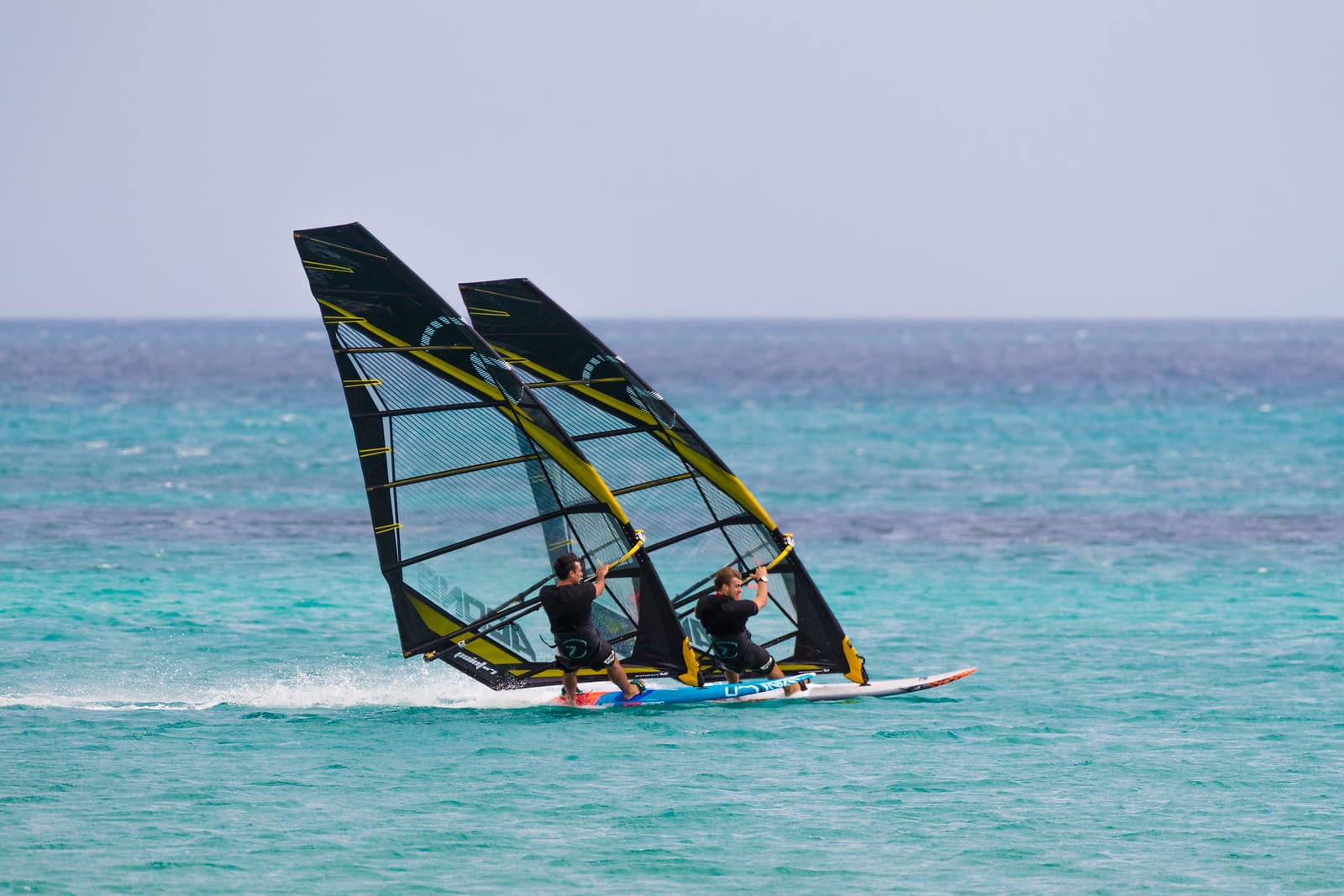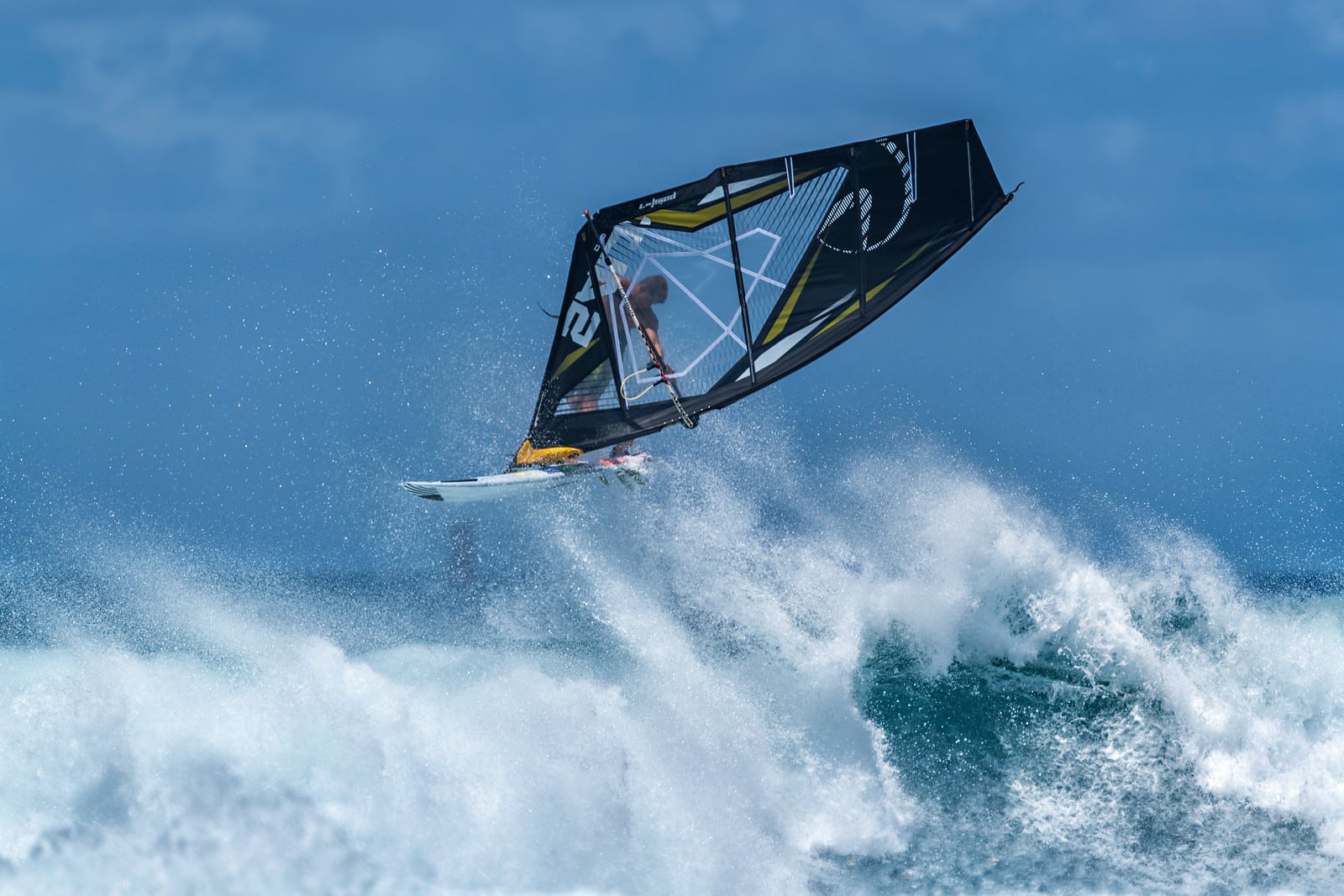As you take in your hand a sail catalogue, you will find 10 different sail models next to each other. Each sail will have a different name, descriptions to make us dream, sizes and numbers that you need to be a mathematician to understand, and unlimited presentations of technical features. For those who just start to windsurf, all of these could sound ARABIC! Side-shore, onshore, neutral, free-wave, pro-am, sport-racer, slalom, racing, power-wave, crossover, free-slalom, freeride, …… every company uses different words to present the type of sail. How to choose the right sail between so many details and technical information?

The first thing to do is to study our needs:
Our windsurfing level: too often we believe to be more radical then what our windsurfing level is, and for fashion or too look good in front of our friends, we often end up in buying a too technical product for our level and needs. We need to be honest with ourselves.
Which are the spot that we go mainly windsurfing to? Yes, it could be that we find 4 metres of waves and 25 knots, but how many times a year? 2? How are the rest of the days?
Is our board compatible to the type of sail we would like?
Can we trust the person who is trying to convince us to buy the sail that he has in the shop? Or is he trying to get rid of it?

Using biking as an example, you can choose to go to the supermarket and buy a bike for 80 euros: this could be the ideal choice to enjoy the fun ride in the park with the family. The other choice would be to enter a pro bike store and buying a 10,000-euro bike to win Le Tour de France. The 2 types of bikes are very different in quality and performance.
Unfortunately, the 80-euro bike does not exist in windsurfing. Every windsurfer, no matter what level they are, will always buy a sail closer to the quality of the 10,000-euro bike, rather than a 80 euro one. To have an 80 euro windsurf equipment would mean inventing something maybe impossible.
An 80-euro windsurfing equipment would be an ideal set up to sell to all the equipped beaches for people to try our sport. An option to any other beach activity, just as a ride in a park on the bike. It will not be a performing windsurfing boards, but even an 80-euro bike, on some dirt downhill would lose its pieces.

The quality of windsurfing equipment between a beginner sail and the one of the professional windsurfer is absolutely the same. Often the material is the same, just the cut and the target of performance is different. Perhaps in some brands some of the reinforcements could be different according to the sail type and therefore the stress it will receive. This comparison is made to explain the fact that even if a freeride sail is bought, it will have the same quality as the highest performing sail for racing or wave riding in the range. The price difference is therefore not coming from the quality of the material used, but more from the time spent in smaller details, sizing, research and development
If you plan to buy a freeride sail, it cannot be compared to buying a 80 euro bike as it’s a cheaper sail, it’s the fact the we would choose a very high quality sail: designed to the pure fun of free riding, fitting therefore perhaps better to our windsurfing needs.
If we put our windsurfing pride on the side during the choice of the sail, we would help ourselves in choosing the correct product and optimise our fun.
Windsurfing offers multiple disciplines, and everyone enjoys this sport according to their preferences.


The most usual ones are:
Freeride: It’s simply cruising. Technical equipment for enjoying the sportive windsurfing for cruising and the most common manoeuvres: tacks, jibes, jumps, duck jibe, body drag, helicopter tack, forward. The equipment can be fast and allows to be radical in the transition if the level of windsurfing is good. It has a wide range of use, and it’s not for beginners as many might think! It’s simply an easier equipment to windsurf in full comfort and freedom! Now days there are different types of freeride sails: some are free-ride sails with some wave characteristics, and some of these sails designed to have a bit of slalom influence. We will explain this further on.

Slalom: If we like to freeride fast in long reaches, with the slalom equipment we can blast around at a higher speed. The adrenaline is higher, but the simplicity of the equipment and control do decrease. If a better technical windsurfing knowledge, this equipment can be trimmed to give a great control and therefore take advantage of the extra speed that the gear can offer. If we are not technical windsurfers, it’s possible that we would be faster on the freeride gear instead of a badly trimmed slalom equipment. The manoeuvrability with the slalom reduces quite a lot. Apart from some long and high jumps, and jibing, other manoeuvres are not interesting to try. Also, for this disciplines there are different sail types: free-slalom (freeride with a slalom influence), to full slalom sails with no cams, or more sportive with 3 cams, or for racing with wider mast sleeves and 4 cambers.

Wave: Living in areas where waves and strong wind are often present, makes the wave equipment a necessity. Wave equipment is often used in strong wind also if there are no waves as it’s offering a great control to enjoy the hard conditions that the wind gives to challenge. When the wind starts being over 20knots, it’s easier to see 90% of the windsurfers on 4.7 wave sails rather than sticking to slalom or freeride sails. Windsurfers with a very high technical level are those who will take these types of sails to real hardcore breaking wave conditions. These sails allow to be radical and express manoeuvres in the air during jumps. Even for this type of discipline, you will be able to find different type of sails: Onshore, Side-shore, Free-wave and in the end the Freestyle sail.
The hardest part during the purchase, is to put on the side that we are like t in the slalom or wave PWA champion! We also don’t have to feel like we are buying something for beginners if we choose something less technical. As explained before every sail in one brand range has the same quality materials in the different sail types. Like in cars. You can buy the same model one having a sports pack, the other having a comfort pack. Both cars would offer the same quality. If you sail out on a 4-cam slalom sail or a simple freeride sail, both sails will offer advantages or disadvantages according to what the windsurfing interest would be. The freeride sails are often seen as beginner’s sail, but these are the actual sails which allow for having a great time and relaxed windsurfing, offering just a lot of fun and holiday feeling.

Lets’ get more into details and find out each type of sail:
Wave ONSHORE or POWER-wave: To give this extra power and stability, they are mainly designed with a 5 batten set up. Do we wave sail in places where the wind is mainly onshore, or the conditions are never very stable? These sails are more locked in while sailing and have a superior stability for very gusty and rough conditions. These sails are also a best choice if our wave level is not very high, or if we are heavy sailors, or if we use a wave sail for strong wind cruising and going for big fast long jumps. The classical bump and jump sail. These sails can be used on smaller free ride board as well. Just like our Spy. Given to be one of the fastest wave sails on the market, with the purpose to hit hard any ramp and go high.
Wave SIDE SHORE, Neutral wave: Often 3 or 4 battens. These sails are very light in the hands and neutral. They have a bit less power when manoeuvring allowing to be very radical in the waves and jumps. They are excellent for side shore wave conditions, but also generally good for all conditions for the better level wave sailors.
Free WAVE: It’s mainly a freeride sail with the outline and batten displacement as wave sail.
It’s great for cruising fully in a comfortable situation and at a same time, if you find a wave, it will welcome you to the experience. As these are freeride sails, they have more power than wave sails, and they can plane in very light wind and even push a bigger volume board. This is due to different batten set up and longer booms.
Free RIDE: Do you just want to have fun, closing yourself in the pure enjoyment of windsurfing, without wanting to take a speed challenge or getting radical? Just the desire to forget about the work week and enjoy the pleasure of planning. This is the right one for you. The comfort of the sail will allow to improve a lot the windsurfing technique.
Free SLALOM: These are free ride sail with an extra batten, and a more slalom outline. If you want to get that extra speed to challenge anyone, without having the hassle of having a too technical slalom sail. The profile and mast sleeve curve, allow to have a very friendly use while sailing. The sail has a lot of power, and you do not need a bigger sail size to get planning as a real slalom sail requires. These are a good on slalom, free slalom and free ride boards.
Slalom Sportive: There are 3 models for this type of sail: 3 cams, 2 cams and no cam. It’s simple to choose between the 3 sails. If your jibing still needs to be improved, and you want something easier for water starting and handling, the no cam is the best solution. The 2 or 3 cams is normally heavier for handling, but still light when sailing. Takes a bit extra technique to rig and the mast sleeve is normally wider and welcomes some extra water to enter and giving extra weight to uphaul or water starting. The acceleration is better on a cambered sail, and if your level of windsurfing is good enough not to fall so often in the jibe, the slight advantage in performance will be appreciated. Speed seekers’, this are the sails to challenge anyone on the water and carve in fast jibes.

Slalom RACING and Freestyle sails: These two types of sails are placed together as they do offer only a very precise range of use: racing and competing. They are both representing an extreme part of windsurfing. If you do real freestyle at a radical level the freestyle sail will be the best option, but if your manoeuvres are limited to the easier and most basic ones, other sail type could be more enjoyable for combining cruising and manoeuvres. For the race sail it’s the same. You would need to sail it in overpowered condition to feel the extra performance, and between a slalom course. This way the speed and acceleration can be very appreciated. The sail with the extra wide pocket and 4 cams are heavier to use then the other slalom sails: if the technical level is not high, you could find out that you could be faster on the no cam sail then the 4cam! These are less friendly use. For both these type of sails the fun will be amazing if you are able to pick the challenge with the high-tech performance, and the other competitive windsurfers on the water.
So before choosing the sail for our windsurfing style, consider the spot conditions you are normally going to and our windsurfing level. Choosing the right sail, will triple your fun!










